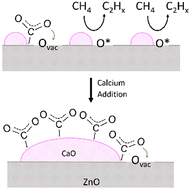Surface basicity controls C–C coupling rates during carbon dioxide-assisted methane coupling over bifunctional Ca/ZnO catalysts†
Abstract
Carbon dioxide-assisted coupling of methane offers an approach to chemically upgrade two greenhouse gases and components of natural gas to produce ethylene and syngas. Prior research on this reaction has concentrated efforts on catalyst discovery, which has indicated that composites comprised of both reducible and basic oxides are especially promising. There is a need for detailed characterization of these bifunctional oxide systems to provide a more fundamental understanding of the active sites and their roles in the reaction. We studied the dependence of physical and electronic properties of Ca-modified ZnO materials on Ca content via X-ray photoelectron and absorption spectroscopies, electron microscopy, and infrared spectroscopic temperature-programmed desorption (IR-TPD). It was found that introduction of only 0.6 mol% Ca onto a ZnO surface is necessary to induce significant improvement in the catalytic production of C2 species: C2 selectivity increases from 5% on un-modified ZnO to 58%, at similar conversions. Evidence presented shows that this selectivity increase results from the formation of an interface between the basic CaO and reducible ZnO phases. The basicity of these interface sites correlates directly with catalytic activity over a wide composition range, and this relationship indicates that moderate CO2 adsorption strength is optimal for CH4 coupling. These results demonstrate, for the first time to our knowledge, a volcano-type relationship between CO2-assisted CH4 coupling activity and catalyst surface basicity, which can inform further catalyst development.



 Please wait while we load your content...
Please wait while we load your content...